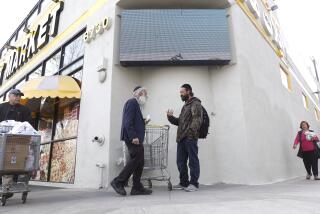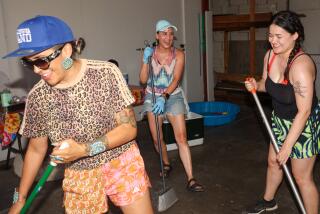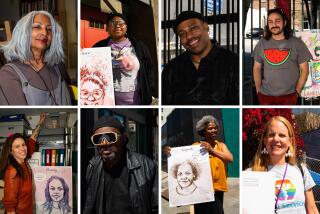Finding Power in Folk Tales
Folk tales arenât just harmless stories people told each other B.T.V. (Before Television), according to three women who will speak Sunday at the Jewish Community Center of South Orange County in Laguna Beach.
Folk tales embody universal truths, and theyâre powerful enough to cross cultural boundaries and carry political messages, say artist Vicki Feldon of Irvine and UC Irvine professors Leslie W. Rabine and Maria Herrera-Sobek .
In Sundayâs presentation, Feldon will tell two Eastern European Jewish folk tales--âThe Golemâ and âThe Dybbukâ--and the professors will give commentaries. The presentation is a satellite event of a conference, âCommunity in Orange County,â being sponsored in various places by the California Council for the Humanities.
Feldon, who won a grant from the California Council for the Humanities for her program, believes folk tales are important for preserving a sense of community and a sense of history.
She said she chose âThe Golemâ and âThe Dybbukâ for the program âbecause they have a certain grandeur about them. Theyâre very universal and very dramatic.â She also thinks people need to be reminded of their heritage: âA lot of people in the Jewish community have become so assimilated that they forget a lot of these thingsâ that define their identity, Feldon said.
âThe Golemâ is a legend about a clay monster who saved the Prague ghetto. The story has one foot in fact. Jews in Eastern Europe were sometimes falsely accused of using the blood of non-Jews in making matzo for Passover. To protect Prague Jews from this accusation, Rabbi Yehuda Loew (a real person who lived from 1512 to 1609) was reputed to have created a golem, a supernatural being made of clay, to guard the community at night.
In the story, the golem shackled the accusers and brought them to the ghettoâs town hall for trial, thus ending the slander. Put back to sleep by Rabbi Loew, the golem was covered with prayer shawls and leaves from prayer books, but it was believed he would rise again if the Jews needed him. The Prague story, Feldon said, is the most popular of the many golem stories in the Jewish tradition.
âThe Dybbukâ is a famous 19th-Century play based on folk stories long cherished by Eastern European Jews. A young man named Khonnon and a young woman, Leye, were promised to each other from birth by their fathers, but Khonnonâs father died, and Leyeâs father wanted his daughter to marry a wealthy man.
On hearing the news that his sweetheart would wed someone else, Khonnon himself died. His spirit came back to possess Leye, was exorcised from her body by rabbis but continued to woo Leye. Ultimately, she chose to die and join him in eternity. âThey both float off in a blaze of light,â said Feldon. âItâs a real five-hankie story.â
Herrera-Sobek, a professor of Spanish, sees parallels between the Jewish tales and stories from Latino culture. âThese motifs are universal,â she said. âOne thing we share is folklore. Most of the time we emphasize differences among ethnic groups. There are a lot of differences, but there are a lot of similarities too,â she said.
âThereâs a very, very old story--my grandmother used to tell it--that every time there was a battle, this prince in a leather jacket would come and he would always win the battle. He would come and he would leave, kind of anonymously.â Because he appeared only when needed, the prince in the leather jacket is a kind of golem, Herrera-Sobek said.
That story probably originated in Spain, she added. âFolklore is spread by diffusion. Now (folk tales) are coming into the urban setting,â she said. âTheyâre really related to the political situation in the community.â
âI think that itâs when people are at their lowest point and donât know where to turn that these legends turn up,â Feldon said.
Rabine, an associate professor of French, thinks modern folk stories divide more often than they unite. âFolk tales in Orange County today are stories of lurid crime,â she said, citing for instance the tale of furloughed Massachusetts murderer Willie Horton, told repeatedly by Republican partisans during the 1988 presidential campaign. âBecause of these stories,â Rabine said, âpeople live in walled communities. There isnât the possibility of community in Orange County as long as people believe in these (modern) folk tales.â
But Feldon thinks that perceiving similarities between storytelling traditions can help create a sense of community. âAccept the fact that people are proud of their ethnicity and then you can be proud of your ethnicity,â she said. âOpen up the little boxes and share.â
ââThe Golem of Pragueâ and âThe Dybbukâ: Two Eastern European Jewish Folk Narratives With Cross-Cultural Commentaryâ will be presented at the Jewish Community Center of South Orange County, 298 Broadway, Laguna Beach, Sunday from 7 to 9 p.m. The program is co-sponsored by the center, the Mexican-American Council of Orange County and the Hispanic Playwrights Project. Refreshments will be served. Admission is free. Information: (714) 497-2070.
More to Read
Sign up for Essential California
The most important California stories and recommendations in your inbox every morning.
You may occasionally receive promotional content from the Los Angeles Times.










